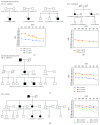Genetic Etiology Study of Ten Chinese Families with Nonsyndromic Hearing Loss
- PMID: 30123251
- PMCID: PMC6079373
- DOI: 10.1155/2018/4920980
Genetic Etiology Study of Ten Chinese Families with Nonsyndromic Hearing Loss
Abstract
Nonsyndromic hearing loss has been shown to have high genetic heterogeneity. In this report, we aimed to disclose the genetic causes of the subjects from the ten Chinese deaf families who did not have pathogenic common genes/mutation. Next-generation sequencing (NGS) of 142 known deafness genes was performed in the probands of ten families followed by cosegregation analysis of all family members. We identified novel pathogenic variants in six families including p.D1806E/p.R1588W, p.R964W/p.R1588W, and p.G17C/p.G1449D in CDH23; p.T584M/p.D1939N in LOXHD1; p.P1225L in MYO7A; and p.K612X in EYA4. Sanger sequencing confirmed that these mutations segregated with the hearing loss of each family. In four families, no pathogenic variants were identified. Our study provided better understanding of the mutation spectrum of hearing loss in the Chinese population.
Figures
References
-
- Zhang L. P., Chai Y. C., Yang T., Wu H. Identification of novel OTOF compound heterozygous mutations by targeted next-generation sequencing in a Chinese patient with auditory neuropathy spectrum disorder. International Journal of Pediatric Otorhinolaryngology. 2013;77(10):1749–1752. doi: 10.1016/j.ijporl.2013.08.007. - DOI - PubMed
Publication types
MeSH terms
Supplementary concepts
LinkOut - more resources
Full Text Sources
Other Literature Sources
Medical



